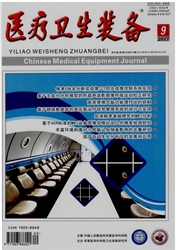

 中文摘要:
中文摘要:
To increase spatial resolution and signal-to-noise ratio in PET imaging, we present in this paper the design and performance evaluation of a PET detector module combining both depth-of-interaction (DOI) and time-offlight (TOF) capabilities. The detector module consists of a staggered dual-layer LYSO block with 2 mm 9 2 mm 9 7 mm crystals. MR-compatible SiPM sensors (MicroFJ-30035-TSV, SensL) are assembled into an 8 9 8 array. SiPM signals from both fast and slow outputs are read out by a 128-channel ASIC chip. To test its performance, a flood histogram is acquired with a 22Na point source on top of the detector, and the energy resolution and the coincidence resolving time (CRT) value for each individual crystal are measured. The flood histogram shows excellent crystal separation in both layers. The average energy resolution at 511 keV is 14.0 and 12.7% at the bottom and top layers, respectively. The average CRT of a single crystal is 635 and 565 ps at the bottom and top layers, respectively. In conclusion, the compact DOI-TOF PET detector module is of excellent crystal identification capability, good energy resolution and reasonable time resolution and has promising application prospective in clinical TOF PET, PET/MRI, and brain PET systems.
 英文摘要:
英文摘要:
To increase spatial resolution and signal-to-noise ratio in PET imaging, we present in this paper the design and performance evaluation of a PET detector module combining both depth-of-interaction (DOI) and time-of-flight (TOF) capabilities. The detector module consists of a staggered dual-layer LYSO block with 2?mm?×?2?mm?×?7?mm crystals. MR-compatible SiPM sensors (MicroFJ-30035-TSV, SensL) are assembled into an 8?×?8 array. SiPM signals from both fast and slow outputs are read out by a 128-channel ASIC chip. To test its performance, a flood histogram is acquired with a 22Na point source on top of the detector, and the energy resolution and the coincidence resolving time (CRT) value for each individual crystal are measured. The flood histogram shows excellent crystal separation in both layers. The average energy resolution at 511?keV is 14.0 and 12.7% at the bottom and top layers, respectively. The average CRT of a single crystal is 635 and 565?ps at the bottom and top layers, respectively. In conclusion, the compact DOI-TOF PET detector module is of excellent crystal identification capability, good energy resolution and reasonable time resolution and has promising application prospective in clinical TOF PET, PET/MRI, and brain PET systems.
 同期刊论文项目
同期刊论文项目
 同项目期刊论文
同项目期刊论文
 期刊信息
期刊信息
